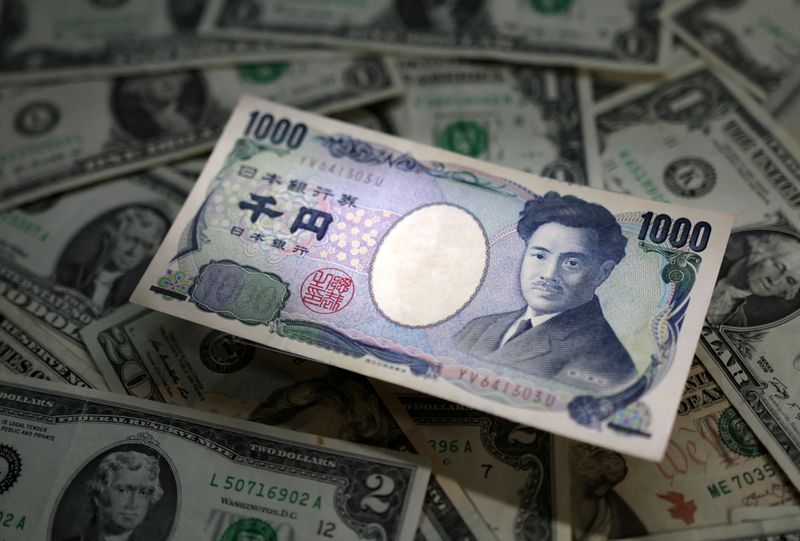Forex
Dollar near six-month high before key central bank decisions


© Reuters. Japanese Yen and U.S. dollar banknotes are seen in this illustration taken March 10, 2023. REUTERS/Dado Ruvic/Illustration
By Harry Robertson and Vidya Ranganathan
LONDON/SINGAPORE (Reuters) – The U.S. dollar hovered near a six-month high on Monday as traders looked ahead to interest rate decisions this week from the Federal Reserve, the Bank of England and the Bank of Japan.
The euro was up 0.1% against the dollar at $1.0667. the yen was up a similar amount at 147.69 to the dollar, with traders out for a Japanese public holiday.
That helped put the , which tracks the currency against six major peers including the euro and the yen, down very slightly at 105.26.
The index rose for its ninth straight week last week as the U.S. economy continued to show strength. It touched 104.53 on Thursday, its highest since the middle of March.
“In the grand scheme of things we’re quite positive on the dollar,” said Alvin Tan, head of Asia FX strategy at RBC Capital Markets. “The U.S. economy is outperforming both Europe and Asia, especially China.”
Traders were looking towards central bank decisions later in the week which could shake up the currency market.
Investors expect the Federal Reserve to keep interest rates on hold in the 5.25% to 5.5% range on Wednesday.
“There’s a very strong consensus for a pause here,” said RBC’s Tan. “But there seems to be an expectation that we could see some hawkishness through the latest dot plot (of policymakers’ rate expectations), given how resilient the U.S. economy has been.”
Traders then see the Bank of England raising rates by 25 basis points to 5.5% on Thursday, in what could be its final hike.
They broadly expect the Bank of Japan to leave rates on hold at -0.1% on Friday, but will watch closely for hints about the policy outlook after Governor Kazuo Ueda stoked speculation of an imminent move away from ultra-loose policy.
In the days since Ueda’s remarks just over a week ago, the yen has dropped 1.3% and taken losses for 2023 to more than 11%.
Carol Kong, economist and currency strategist at Commonwealth Bank of Australia (OTC:), said she expects the yen to be volatile leading up to the policy meeting and that investors may have potentially misinterpreted Ueda’s comments.
“Dollar/yen can definitely track higher … particularly if Governor Ueda sounds dovish and dashes hopes of policy tightening at the upcoming meeting,” she said.
Sterling was last trading at $1.2396, up 0.1% on the day. British inflation data is due on Wednesday and is likely to move the pound ahead of the BoE decision.
Many analysts expect that stark divergences in economic growth and yields will keep the dollar mostly propped up, particularly against the euro.
Sterling has slid nearly 6% against the dollar since mid-July, while the euro has dropped more than 5% as the British labour market and economy and the euro zone economy slowed.
The European Central Bank raised interest rates to 4% last week, but said this hike could be its last.
Meanwhile, oil prices are at around $94, adding a layer of complication to central banks’ growth-inflation dilemmas. Oil is also on track for its biggest quarterly increase since Russia’s invasion of Ukraine in the first quarter of 2022.
Australia’s dollar was up 0.1% at $0.6437.

 Forex3 years ago
Forex3 years agoForex Today: the dollar is gaining strength amid gloomy sentiment at the start of the Fed’s week

 Forex3 years ago
Forex3 years agoUnbiased review of Pocket Option broker

 Forex3 years ago
Forex3 years agoDollar to pound sterling exchange rate today: Pound plummeted to its lowest since 1985

 Forex3 years ago
Forex3 years agoHow is the Australian dollar doing today?

 Cryptocurrency3 years ago
Cryptocurrency3 years agoWhat happened in the crypto market – current events today

 World3 years ago
World3 years agoWhy are modern video games an art form?

 Commodities3 years ago
Commodities3 years agoCopper continues to fall in price on expectations of lower demand in China

 Economy3 years ago
Economy3 years agoCrude oil tankers double in price due to EU anti-Russian sanctions





















